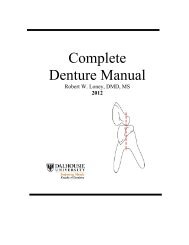RPD Manual 11 - Removable Prosthodontics - Dalhousie University
RPD Manual 11 - Removable Prosthodontics - Dalhousie University
RPD Manual 11 - Removable Prosthodontics - Dalhousie University
You also want an ePaper? Increase the reach of your titles
YUMPU automatically turns print PDFs into web optimized ePapers that Google loves.
Major Connectors - 36<br />
B. Full Palatal Plate<br />
The full palatal plate is particularly indicated when maximum<br />
tissue support is required. In particular it should be the major<br />
connector of choice in long distal extension cases or where<br />
six or less anterior teeth remain. It should be selected where<br />
the primary abutments are periodontally involved, requiring<br />
maximum stress distribution. Where the edentulous areas are<br />
covered with flabby tissue or where there is a shallow palatal<br />
vault this connector also provides greater stability and stress<br />
distributing characteristics. The full palatal plate is usually<br />
not used in the presence of torus palatinus.<br />
The full palatal connector should be fabricated of a uniformly thin metal plate with accurate<br />
anatomic reproduction of the rugae configuration (improves strength and rigidity). It should<br />
cover the same area as a complete denture posteriorly. The large surface area of contact with the<br />
mucosa improves the potential for retention.<br />
Connectors of this type are generally of cast metal. However an acrylic resin plate may be used<br />
in interim prostheses.<br />
C. Palatal Strap (or Bar)<br />
This type of connector can be wide (strap) or narrow (bar)<br />
depending upon its location or the need for strength or<br />
support of the denture. The palatal bar should only be used<br />
in tooth supported cases where no other connector can be<br />
used. It is usually objectionable due to its bulk. It should<br />
never be used in cases involving distal extensions or<br />
replacement of anterior teeth since it must be made to bulky<br />
for rigidity.<br />
The palatal strap is similar, but with a broader area of contact, providing better stabilization and<br />
stress distributing properties with minimum bulk. Therefore it is preferable to the palatal bar for<br />
posterior tooth supported cases. However, other connectors should be chosen if there is a large<br />
torus or if many teeth are being replaced.<br />
Relief may be required over bony midline areas in some instances to prevent fulcruming over the<br />
overlying soft tissue. In these cases one thickness of 28 gauge wax relief should be placed over<br />
the midline.















